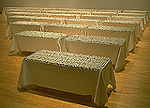IMPOSSIBLE OBJECTS |

|
|
|
Allan McCollum at the International Facility for Lightning research, preparing rocket used to trigger lightning, at Camp Blanding, Florida. 1997. |
Central Florida is known as "The Lightning Capital of North America," receiving as it does more lightning than any other region on the continent. Nestled in between the warm waters of the Gulf of Mexico and the cooler Atlantic Ocean, the lightning phenomenon of the region explains the location of the Lightning Research field at Camp Blanding. McCollum's engagement with the regional site was not predicated upon its inhabitants or culture, but rather took as its base a more traditional notion of the uniqueness of places — the landscape, the terrain, the weather.
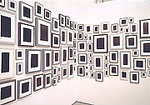
|
|
|
Alllan McCollum. Plaster Surrogates. 1982/84. Enamel on cast Hydrostone. |
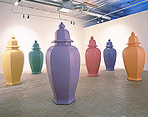
|
|
|
Allan McCollum. Perfect Vehicles, 1988. Acrylic paint on glass fiber reinforced concrete. |
While many artists of McCollum's generation focused on how the museum/gallery nexus defines and determines the meaning of art objects, they tended to neglect the space of the home, be it the home of the art collector or the "average" person. Along with Louise Lawler (with whom he occasionally collaborated) McCollum's work, however, continually referenced domestic space as well as the museum as one of the major sites for art, a site integral to the creation and maintenance of art's meaning. So the Surrogates' salon-style hanging, and the accumulation of the Perfect Vehicles, also evoked the displays of pictures and collected objects (not necessarily considered Art) typically found in domestic space as opposed to the modernist museum. This mode of display, combined with the mass-produced generic quality of McCollum's work, poignantly evoked the ways in which we display objects in our homes as a means to display our very identity. This sense of how our identities are bound up with our objects was perhaps made clearer when McCollum enlarged the Vehicles to slightly larger than life-sized, making them monumental, and memorializing.
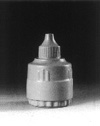

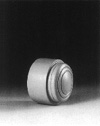
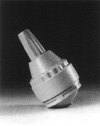
Allan McCollum. Over Ten Thousand Individual Works, details. 1987/88.
So much of what humans make, however, is destined for the trash heap of history, not to be enshrined in the museum, but instead relegated to the world of commodities and mass consumption. No work of McCollum's dealt with this better than Over Ten Thousand Individual Works. Here over ten thousand objects all the same color were displayed atop a long table. The objects were made from a series of repeating tops and bottoms combined according to a mathematical system that allowed for each object to be unique, individual. The patterns for these parts were taken from common household items such as bottle caps, paper weights, cat toys, shade pulls, etc. Here the logic of mass production is laid out on the table. In the face of the mass, the proliferation of the same, there grows a contrary desire for the unique, the individual. Art, in particular, is asked to carry the burden of this desire. A paradoxical situation developed: just as the historical juncture of the industrial revolution made art available to the masses through mass production and the development of photography, a desire was born for it to remain elite by being unique. In Individual Works the tension between the mass and the individual is made clear. Each object is unique, but they are all so very much the same. Their pleasure lies in the compare and contrast, in the proliferation of objects, as opposed to any singular one. Individual Works proposes that one's desire may be for the mass after all. The analog for this experience in everyday life is the pleasure and fatigue of shopping, the constant demand to pick something out of the great repeated mass of objects. More importantly, the demand is to pick something that exemplifies your uniqueness; a mass-produced object that "speaks to you", that "is" you, a mass-produced object that will help to create and maintain your sense of individuality.

|
|
|
Allan McCollum. Over Ten Thousand Individual Works, (detail) 1987/88. Enamel paint on Hydrocal. |

|
|
|
Lightning strike that formed the fulgurite, Camp Blanding, Florida. |
McCollum's earlier work surmised that our response to the mass is to attempt desperately to individuate in the face of it. What then, this project asks, is the human response to the singular event? Particularly a singular natural event, one of significant drama or beauty? And once again, McCollum's mode of production points toward one of the answers. For one of the more significant site-specific aspects of the fulgurite project is that, instead of casting and fabricating these objects in his New York studio, McCollum worked with Sand Creations, a small souvenir factory in Central Florida.
We have all encountered the types of souvenirs made by Sand Creations — sand dollars, starfish, flamingos — mementos of vacations, little repositories of memory. One way to think about the souvenir is to see it as experience objectified, nature transformed into an object that can be placed at a remove or distance so that it might be able to be grasped. A fulgurite is like a souvenir made by nature; it's as if lightning objectifies itself, transforming itself from a sublime, instantaneous moment of electrical power, into a craggy misshapen glass tube, a trinket, a tchotchke of sorts. And true to the souvenir, the fulgurite does little either to encompass or to convey the awesome visual and sensorial impact of lightning.
Souvenirs, from the French verb to remember, are mnemonic devices. We buy them as a means to an end, as a way to fix a transitory experience, usually one that exceeds our ability to convey it to other people (the "you had to be there" effect). They offer us opportunities to tell a story, they provide us with moments when we are able to summon our pasts forward into the present; they permit the mingling of past and present. A form of evidence, proof that something has happened, the souvenir is an attempt to congeal experience into a thing, a thing to be carried, to be displayed, ultimately, perhaps, to be forgotten. In a culture dominated by tourism the souvenir acts as a way to "authenticate" our experience. Yet as it has become progressively harder to distinguish the specificity of places, as the experiences of travel and tourism have become homogenized, it may be that the souvenir is now asked to aid in the increasingly difficult project of differentiation. For this we need only look to all the airports' "regional" gift shops, replete as they are with the ubiquitous salt-water taffy, and t-shirts and refrigerator magnets that sport an endless substitution of place names.
In this struggle for differentiation the vast majority of souvenirs inhabit and produce a particular brand of kitsch. This is not surprising, given that their task is to contract an overwhelming experience of travel, love, another place, a natural site or event of great beauty into a thing, an object. But McCollum's fulgurites, if we see them as a form of souvenir, are resolutely not spectacular, not kitsch, not conventionally beautiful. If anything, they court the banal. Lying row after row on the table, small, gray, unspectacular, they seem stubborn in the way in which they deny the sublimity of their electrical progenitor. But McCollum's fulgurites also lie on the table, abjectly undifferentiated, looking like cast-offs, residues, by-products. In discussing this aspect of McCollum's work Rosalind Krauss has argued that undifferentiated repetition transforms "the space of difference into an undifferentiable entropic continuum." Entropic because without differences it is impossible to produce meaning, because without difference meaning congeals. The congealed nature of meaning is of course supported formally by McCollum's use of casting. And casting lends itself to repetition, a repetition so often experienced as banal. And this is supported again by the dejected quality of the fulgurites, their quality of extruded uselessness.
But all of McCollum's works have courted the banal, the common, the ordinary. Here, though, this use of the banal is more pointed, and it emerges as a strategy of sorts. In this work banality seems to be used as a way to guard against kitsch. Banality is used here, not as a way to empty the objects of their meaning, but rather as a way to reconfigure the grid upon whose coordinates meaning is drawn. The cast fulgurites refuse both the monumentality of the high art object and the glittering kitsch of the souvenir. Banality is offered as a means to ward off the sublime and a corresponding aesthetic tendency toward emotional kitsch. In the re-mapping of the grid, these cast fulgurites lack a certain legibility. They don't necessarily read as art objects (after all, they're the type of object you might normally find in a natural history museum), neither do they read as an accurate scientific representation of fulgurites, for real fulgurites are tubes, with only one possible closed end (a "terminal sack" in the language of fulgurite specialists). McCollum's experiment designed the fulgurites in such a way that they are closed on both ends. They relinquish the sublimity of lightning for the banal, and they eschew the scientifically accurate for the aesthetic choices of the artist. Hence, they rest uncomfortably somewhere between the art museum and the natural history museum, not quite adequate to the specifications or demands ofeither institution.
6. McCollum's move outside of the art museum permits us to see some of the extra-aesthetic ideas that have been at play throughout the body of his work. In the 1980s explorations of the copy, in both art and its attendant criticism, tended to presume (and champion) a copy without an original; moments when "the original and the copy [were] indistinguishable." The Event, however, suggests that copies without originals might not be the only, or even the most important problematic, but rather the more difficult and resonant question might be about the relation between history and objects. What happens when we ask objects to stand in for history, to convey the past, to tell our stories for us? What happens when our experiences are congealed into things; transformed into souvenirs, art objects, commodities? In the early decades of the twentieth century, when the logic of the mass-produced commodity consolidated its stronghold on the daily lives and imaginations of citizens of the developed world, the German philosopher Walter Benjamin attempted to theorize the relations between the fossil and the commodity object. Both, he suggested were reified; experience, history, made thing-like. Yet, for Benjamin, the fossil offered a way to cleave open the commodity, to disarticulate its objectness, to render it both permeable to, and a repository of, history. If there was a correlation between the cultural and natural worlds, then perhaps it could be ascertained by thinking the dialectical relation between nature and history. If the fossil, via Darwin, proved that nature was not an undifferentiated, entropic, ahistorical continuum, so too, perhaps, the commodity could be seen as history congealed into a thing, but a thing that punctuated the "naturalness" of history. The task then, of the historian or the artist — of critical thought — was to de-objectify the commodity, to transform the commodity from the realm of stasis to the realm of process, to reinvest the thing with experience, with history.
7. McCollum's cast fulgurites are neither souvenirs nor fossils, but an attempt to register the relations between the two. That is, the souvenir and the fossil both provide evidence of transformations; one natural, the other cultural, they represent transformations of time, place, and experience into things, objects. So these objects also point to the extraordinary burdens we place upon our objects, and the myriad institutions we create to arbitrate those desires, among them the art museum, the natural history museum, the souvenir shop and the collector's home. This work, therefore, participates again in the poignant desire to have objects tell us who we are, poignant because the souvenir is destined to be forgotten, and actual fulgurites encountered in the field will often crumble and disintegrate upon contact. This is the paradox of McCollum's work, its use of repetitive casting as a formal device and banality as a strategy for creating meaning can be seen as an attempt to reanimate the (art, commodity, souvenir) object, to endow it with process, experience, history — to pluck it from the continuum of undifferentiated meaning. In The Event McCollum's not souvenirs/not art objects, his non-singular object for a singular event, show us that no amount of repetition can ever compensate for the singular. That the singular, in a world dominated by repetition, is always slightly beyond reach, just shy of being attainable — an impossible object.
Helen Molesworth1998, New York City.

